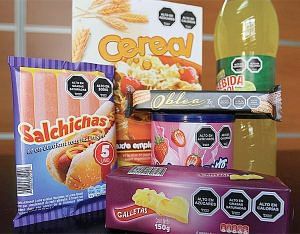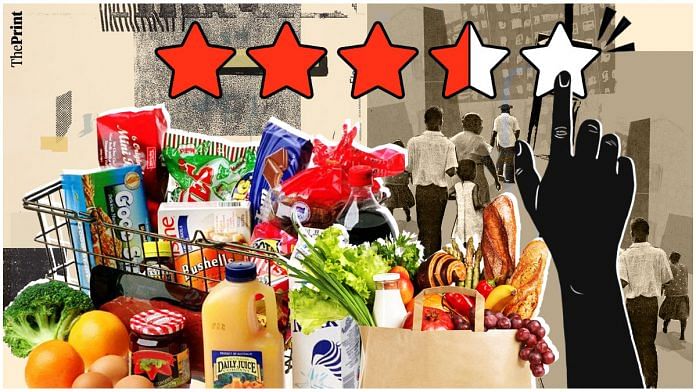Shafali Mittal has had a strict ‘no junk food in the house’ rule. She should know — she has studied diet and nutrition. But ready-to-eat packed snacks with poor health labels are weakening her grip on what her two sons, aged 17 and 23, eat. For the past eight years, India has been debating how to come up with front-of-pack labels, in addition to technical back-of-pack displays, while making them more consumer friendly—simple star ratings or colour coded warnings.
The decision, which is expected soon, is likely to speak to many parents like Mittal. Right now, nothing on the food packages tells her how much of it is unhealthy.

Countries like Australia, New Zealand, Chile, Israel, Peru, Brazil, and Mexico, among others, use a range of front-of-pack-labelling which indicates to the consumer, in less than 10 seconds, how unhealthy a food product is. The idea of the label, about an inch big, is to nudge the consumer to select healthier foods. Plethora of studies done in these countries show which label has worked and which hasn’t.
The Food Safety and Standards Authority of India (FSSAI) has been deliberating which label to adapt for the country. It should bring information on excess harmful nutrients—primarily fat, salt and sugar—more prominently on food packets to ensure that the consumers make informed choices about what they eat.
Everything hinges on the design. In the FSSAI meetings, the tussle is between two main symbols—warning signs used by Chile, and the health star rating used by Australia. But a series of documents accessed by ThePrint show that decision-making on front-of-pack-labelling within the FSSAI is allegedly severely compromised in favour of food giants. It rejected previous draft proposals such as a robust colour indication and adhering to nutrient thresholds set by the World Health Organization’s South-East Asia Regional Office (WHO-SEARO).
Instead, FSSAI is now charging ahead with a health star rating, which has had no impact on reducing unhealthy food consumption in the countries where it was implemented. Despite public health and consumer groups vehemently disagreeing to the star rating, FSSAI is drafting new regulations that it will put in public domain soon. At least three stakeholders who took part in the consultancy meetings said that FSSAI is in the process of devising algorithms to rate food, based on which stars will be assigned to them.
Not everyone is convinced. “Health star rating creates a health halo around unhealthy products. It minimises the unhealthy nature of the product. As a consumer I feel that even if it has one star, it’s less healthy, but it’s healthy. That’s the basic flaw with this,” says Arun Gupta, convenor of Nutrition Advocacy in Public Interest, a group representing public health experts.
Also read: Your modern diet is contributing to climate change — but here’s how you can fix it
The right tag
It took countless meetings with food producers, industry representatives, nutrition scientists, doctors, consumer groups, and crores of rupees on commissioned studies for the FSSAI to decide which sign on food packets would best tell the consumers about the high salt, sugar and fat in it.
An alarming rise in non-communicable diseases in adults as well as in children is a trigger for this policy move. Scientific evidence directly links consumption of foods and beverages rich in sugar, salt and fats to illnesses such as obesity, hypertension, heart diseases, stroke, depression, even cancer.
Studies in Chile, which uses a black hexagonal sign saying ‘high in’ salt, sugar or fat, show that consumption of sugary drinks dropped to 24 per cent. Australia, on the other hand, gives stars to foods. Higher the salt, sugar or fat in food packets, fewer the stars it will get and vice versa. The star rating will improve if positive ingredients are added in the food, such as nuts or fruits. Evidence shows such health star ratings have had no significant impact in changing consumption behaviour.
Despite global evidence, on 15 February 2022, the FSSAI selected the health star rating for India based on the recommendations of a study by the Indian Institute of Management-Ahmedabad, which it had commissioned in 2021.
Researchers took inputs from a sample survey of more than 20,000 participants for five symbols. And it was a close fight between two of them—warning labels and health-star rating. The star rating wins for ease of identification and understanding of labels, but warning labels get a better rank and score when it comes to ease of identification of a nutrient which is in excess.

While food industry representatives have agreed to implement the star symbols, consumer groups smell a rat.
A star rating is not nutrient-specific. It doesn’t tell if a product has less stars because of more salt, sugar or fat, explains Amit Khurana, programme director, sustainable food systems, Centre for Science and Environment, a think-tank.
This positive symbol on packs, along with extra points for positive nutrients, is a perfect recipe, which food manufacturers will easily exploit, says Gupta.
“If you add fruit juice to an aerated drink, or remove sugar and add a sweetener, the product will get a better star. It will still contain high amounts of sugar. But this suits the industry because this way, they can keep the consumer confused,” says Gupta.
Fads like nuts in chocolates, fruits in cereal, multigrain in flour and many more such formulations are already used by the industry.
Defending the selection, Pawan Kumar Agarwal, FSSAI’s former chief executive officer who headed the meetings on front-of-pack-labelling during his tenure, says that a beginning must be made, irrespective of the label.
“There is no perfect model. No country in the world can claim that they have got it quickly and rightly. Even for Chile and other countries, it took them several years to get to where they are now,” Agarwal says. “If over the last 4-5 years it has been found something will work in India, I think we should go ahead with it. It is not cast in stone. It is already very delayed.”
Meanwhile, the industry, in FSSAI’s meetings, has agreed to abide by the new labelling rules when they are implemented.
ThePrint made several attempts to reach out to the Federation of Indian Chambers of Commerce & Industry (FICCI) and the Confederation of Indian Industry (CII), two industry bodies represented in FSSAI meetings, but could not get a response.
Also read: Don’t trust the ‘superfood’ label. Here are five common foods to boost your health
The long wait
The ground for front-of-pack-labelling in India was laid in 2010, when hearing a public interest litigation on banning unhealthy, processed food in schools, the Delhi High Court asked the FSSAI to take measures to regulate junk food. The labelling was first discussed by the FSSAI in 2014 and later in 2018. After inputs from expert groups, the FSSAI released a draft, also adapting the thresholds set by the WHO-SEARO for salt, sugar and fat consumption.
The FSSAI did away with the WHO-SEARO thresholds in its subsequent draft in 2019, and introduced new thresholds which the consumer groups allege are unscientific. This upping the limit of salt, sugar and fats will push a lot of unhealthy packed snacks in the so-called ‘healthy’ category where they would not require a front-of-pack-labelling.
Defending its stance on thresholds, the FSSAI said, “Earlier thresholds were based on the WHO-SEARO model, which is suggestive and not implemented as such in any of the countries. The stakeholders raised various concerns on the same and no consensus could be made. Hence, the scientific panel reviewed the categories and thresholds proposed in the draft regulations, 2019 and the current proposed thresholds take into account global models implemented across various countries & WHO-Population Nutrient Intake Goals.”
Agarwal, under whose tenure the thresholds were revised, explains that the WHO-SEARO thresholds reduce the contents in snacks in India by almost 80 per cent, making them too bland for the Indian palette. “If the threshold we give is very different from the consumption pattern of the population, then these will not be implemented at all. The process of reduction of salt, sugar has to be gradual. It cannot happen in a day or a year. We did a very detailed analysis and revisited these thresholds,” he says.
In 2017, according to Agarwal, FSSAI took pledges from companies to reduce salt, sugar and fat in their foods. About 20 companies came forward but their initiatives had limited success.
“Food businesses are for-profit entities. When they are competing with each other for market shares, assuming that they will behave differently and focus on nutrition at the cost of market shares and profits is wrong,” he says.
In February 2022, the FSSAI announced in the stakeholders’ meeting that the labelling will be voluntary for four years and then made mandatory. FSSAI says this is the global norm and the “path-breaking” front-of-pack-labelling needs time to be accepted by the companies.
Smaller food manufacturers and traders who make up 75 per cent of the Indian market were never consulted while deliberating front-of-pack-labelling, according to Praveen Khandelwal, founder and general secretary of Confederation of All India Traders, a group representing over eight crore businesspersons including food manufacturers. “FSSAI calls big industry representatives like FICCI, CII and a handful of other food giants who represent only 15 per cent of the business. Though the smaller players will abide by new rules, their concerns need to be heard at stakeholders’ meetings.”
On allegations that the food industry is influencing its decisions, the FSSAI says that both consumer groups as well as industry associations have been an integral part of the consultations and their comments will be considered before final notification is issued.
Meanwhile, the cry for stricter regulation on harmful food is growing louder. In India, one in four adults and one in 20 children are either overweight or obese. These numbers are growing faster than the world average and unless there is an intervention, these numbers will triple by 2040, according to the World Obesity Federation.
Also read: Should you fall for anything labelled ‘diet’? Think again on diet soda
The impact of changing lifestyles
Mittal’s older son, Madhav, is back home from Singapore and her days are spent taking him to dermatologists. “His skin has lost sheen and his hair is falling. The doctors tell me it is because of lack of nutrition,” she says.
A large part of Madhav’s diet in Singapore has been ready-to-eat Indian food packets and that is apparently now showing results, Mittal says.
“The future is packed food. With busy work and social lives and 10-minute delivery apps, it is so convenient to just buy everything,” she says. But is anyone checking what these companies are adding to those sealed packets, she wonders.
(Edited by Zoya Bhatti)



